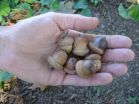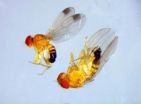(Press-News.org) CHICAGO – In a study that included a nationally representative sample of nearly 45,000 adults, participants who met more of seven recommended cardiovascular health behaviors or factors (such as not smoking, having normal cholesterol levels, eating a healthy diet), had a lower risk of death compared to participants who met fewer factors, although only a low percentage of adults met all seven factors, according to a study appearing in JAMA. The study is being published early online to coincide with its presentation at a specialty meeting of the American Heart Association.
"Cardiovascular disease (CVD) is the leading cause of deaths in the United States [greater than 800,000, or about 1 in 3 overall deaths/year], with estimated annual direct and overall costs of $273 billion and $444 billion, respectively," according to background information in the article. The American Heart Association (AHA) recently published recommendations aimed at improving cardiovascular health and reducing deaths from CVD in the United States by encouraging the general population to meet seven defined ideal cardiovascular health behaviors or factors (for this study, called cardiovascular health metrics). The metrics are not smoking; being physically active; having normal blood pressure, blood glucose and total cholesterol levels, and weight; and eating a healthy diet.
Quanhe Yang, Ph.D., of the Centers for Disease Control and Prevention, Atlanta, and colleagues conducted a study to examine the trends of these health metrics and estimated their associations with risk of all-cause and CVD mortality. The study included 44,959 U.S. adults (age 20 years or older), using data from the National Health and Nutrition Examination Survey (NHANES) 1988-1994,1999-2004, and 2005-2010 and the NHANES III Linked Mortality File (through 2006).
The researchers found that regarding trends over the study period, the prevalence of current smoking continued to decline since 1988. However, the desirable level of untreated blood pressure and total cholesterol level remained unchanged, and the prevalence of desirable levels of body mass index (BMI) (less than 25) and fasting glucose continued to decline for the study period.
Few participants met all 7 cardiovascular health metrics (2.0 percent in 1988-1994, 1.2 percent in 2005-2010). Younger participants, women, non-Hispanic whites, and those with higher education levels tended to meet a greater number of cardiovascular health metrics.
The authors found that meeting a greater number of cardiovascular health metrics was associated with a significantly lower risk of all-cause, CVD, and ischemic heart disease (IHD) mortality. "During a median [midpoint] of 14.5 years of follow-up in the NHANES III Linked Mortality File cohort, participants who met 6 or more vs. 1 or fewer cardiovascular health metrics had a 51 percent lower risk of all-cause mortality, a 76 percent lower risk of CVD mortality, and a 70 percent lower risk of IHD mortality. In addition, meeting a greater number of cardiovascular health metrics also appeared to be associated with lower risk for all-cancer mortality."
The researchers add that a significant interaction between cardiovascular health metrics and age group (less than 60 vs. 60 years or older) on CVD mortality suggested that meeting cardiovascular health metrics might offer greater protection against premature CVD deaths among younger participants.
"In summary, our findings indicate that the presence of a greater number of cardiovascular health metrics was associated with a graded and significantly lower risk of total and CVD mortality," the authors write.
"Healthy People 2020 and the AHA's national strategy to reduce CVD morbidity and mortality by 20 percent by 2020 through promoting ideal cardiovascular health metrics represents a great challenge but also an achievable goal. Coordinated efforts, such as the recently announced Million Hearts initiative, align CVD prevention and control activities across the public and private sectors, creating opportunities to reduce the burden of CVD across a large segment of the population."
(JAMA. 2012;307[12]:doi:10.1001/JAMA.2012.339. Available pre-embargo to the media at www.jamamedia.org)
Editor's Note: The authors have completed and submitted the ICMJE Form for Disclosure of Potential Conflicts of Interest and none were reported.
Editorial: Improving the Cardiovascular Health of the U.S. Population
In an accompanying editorial, Donald M. Lloyd-Jones, M.D., Sc.M., of the Northwestern University Feinberg School of Medicine, Chicago, writes that regarding what can be done to improve cardiovascular health, a proposed concept to shift the population distribution toward greater health is the key.
"Despite the apparent difficulties in achieving the goal, there is much to be optimistic about, and opportunities abound for physicians, policy makers, and consumers to support improvements in cardiovascular health. Continued focus through the health care system on meeting primary and secondary prevention targets is critically important, so that individuals at risk can take one step forward from poor to intermediate cardiovascular health. Advocacy will be needed for new public health and social policies to tilt the playing field toward healthier choices, so more individuals can move from intermediate to ideal levels or maintain ideal cardiovascular health. The debate over this year's farm bill, which will set policy for years to come, represents an opportunity for advocacy for cardiovascular health and a healthier food supply for all. Efforts to reduce sodium in the food supply are ongoing on multiple fronts."
(doi:10.1001/JAMA.2012.361. Available pre-embargo to the media at www.jamamedia.org)
Editor's Note: The author has completed and submitted the ICMJE Form for Disclosure of Potential Conflicts of Interest and none were reported.
###
To contact Quanhe Yang, Ph.D., call Karen Gailey at 770-488-8087 or email kgailey@cdc.gov. To contact editorial author Donald M. Lloyd-Jones, M.D., Sc.M., call Marla Paul at 312-503-8928 or email marla-paul@northwestern.edu.
Meeting greater number of recommended cardiovascular health factors linked with lower risk of death
2012-03-19
ELSE PRESS RELEASES FROM THIS DATE:
Lyme disease surge predicted for the northeastern US
2012-03-19
The northeastern U.S. should prepare for a surge in Lyme disease this spring. And we can blame fluctuations in acorns and mouse populations, not the mild winter. So reports Dr. Richard S. Ostfeld, a disease ecologist at the Cary Institute of Ecosystem Studies in Millbrook, NY.
What do acorns have to do with illness? Acorn crops vary from year-to-year, with boom-and-bust cycles influencing the winter survival and breeding success of white-footed mice. These small mammals pack a one-two punch: they are preferred hosts for black-legged ticks and they are very effective ...
Nano rescues skin
2012-03-19
Nanoparticles containing chitosan have been shown to have effective antimicrobial activity against Staphylococcus saprophyticus and Escherichia coli. The materials could be used as a protective wound-healing material to avoid opportunistic infection as well as working to facilitate wound healing.
Chitosan is a natural, non-toxic and biodegradable, polysaccharide readily obtained from chitin, the main component of the shells of shrimp, lobster and the beak of the octopus and squid. Its antimicrobial activity is well known and has been exploited in dentistry to prevent ...
Novel plastics and textiles from waste with the use of microbes
2012-03-19
New biotechnological and chemical methods will facilitate efficient production of chemicals, materials and fuels from renewable natural resources. The Academy of Finland Centre of Excellence (CoE) in White Biotechnology – Green Chemistry Research focuses on the research and development of microbial cells, or cell factories, for producing new useful compounds from sugars in plant biomass. These compounds can be used, for example, for manufacturing bioplastics or in medical applications.
"By means of gene technology, we can modify microbial metabolism and thereby produce ...
An invasive Asian fly is taking over European fruit
2012-03-19
Coming from the Asian continent, Drosophila suzukii has only been in Spain for a short time. Far away from slipping through into the Iberian Peninsula, it accelerated towards the north of Europe where it has already crossed the Alps. Amongst its preferred target are cherries and red fruits but any type of fruit is suitable for it to lay its eggs. This insect is posing a threat to the fruit of more and more European countries.
"Out of the 3,000 known species of Drosophilae, commonly named the vinegar fly, only two are potentially dangerous to fruit crops. One of them is ...
Survival of the fittest -- ESF hosts session on the challenges of life in extreme environments
2012-03-19
Have you ever wondered how life is sustained in environments like deserts, deep seas or the polar regions? How do organisms adapt and thrive in such harsh conditions, and what challenges do they face as a result of human activities and climate change, especially climate "extremization"? Shedding light on some of these issues is the objective of the European Science Foundation's (ESF) session on 27 March at Planet Under Pressure 2012. The session will look at different aspects of life in extreme environments - from knowledge to sustainable exploitation of new resources under ...
Treating psoriasis to prevent heart attacks and strokes
2012-03-19
Montreal, March 16, 2012 – A clinical study co-led by the Montreal Heart Institute and Innovaderm Research Inc., which was presented today at the annual meeting of the American Academy of Dermatology, shows that a new treatment for psoriasis could be associated with a significant decrease in vascular inflammation, a major risk factor of cardiovascular disease.
Psoriasis is a chronic inflammatory disease of the skin and joints that affects up to 3% of the population. This disease is associated with a greater risk of heart attack (infarction) and stroke. The goal of this ...
Early spring drives butterfly population declines
2012-03-19
Early snowmelt caused by climate change in the Colorado Rocky Mountains snowballs into two chains of events: a decrease in the number of flowers, which, in turn, decreases available nectar. The result is decline in a population of the Mormon Fritillary butterfly, Speyeria mormonia.
Using long-term data on date of snowmelt, butterfly population sizes and flower numbers at the Rocky Mountain Biological Laboratory, Carol Boggs, a biologist at Stanford University, and colleagues uncovered multiple effects of early snowmelt on the growth rate of an insect population.
"Predicting ...
Hiding in plain sight, new frog species found in New York City
2012-03-19
In the wilds of New York City--or as wild as you can get that close to skyscrapers--scientists have found a new leopard frog species.
For years, biologists mistook it for a more widespread variety of leopard frog.
While biologists regularly discover new species in remote rainforests, finding this one in ponds and marshes--sometimes within view of the Statue of Liberty--is a big surprise, said scientists from the University of California, Los Angeles; Rutgers University; the University of California, Davis and the University of Alabama.
"For a new species to go unrecognized ...
Checking off symptoms online affects our perceptions of risk
2012-03-19
You've been feeling under the weather. You Google your symptoms. A half-hour later, you're convinced it's nothing serious—or afraid you have cancer. More than 60 percent of Americans get their health information online, and a majority of those decide whether to see a doctor based on what they find. "Wow, this is an era of self-diagnosis," thought Arizona State University psychologist Virginia Kwan, learning that statistic. How might information accessed online affect individual health decisions?
In a new study, Kwan and her colleagues found that the way information is ...
Researchers uncover molecular pathway through which common yeast becomes fungal pathogen
2012-03-19
TORONTO, ON—Scientists at the University of Toronto have found a molecular mechanism that plays a key role in the transition of Candida albicans yeast into disease-causing fungus—one of the leading causes of hospital-acquired infection. The finding highlights the importance of heat in fungal growth, and provides a new target for drug therapies to counter Candida albicans infection.
Candida albicans is a normally harmless yeast that is present in all humans. It becomes infectious in various genetic and environmental conditions, with temperature as a key determinant. It ...



